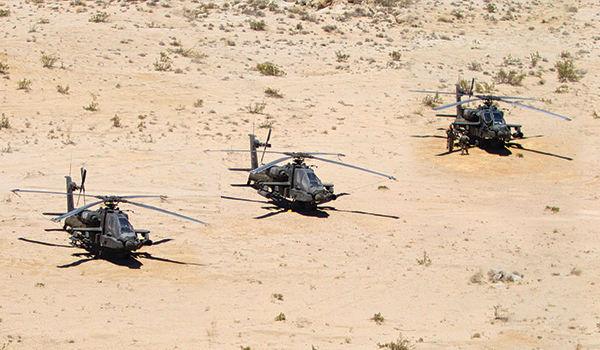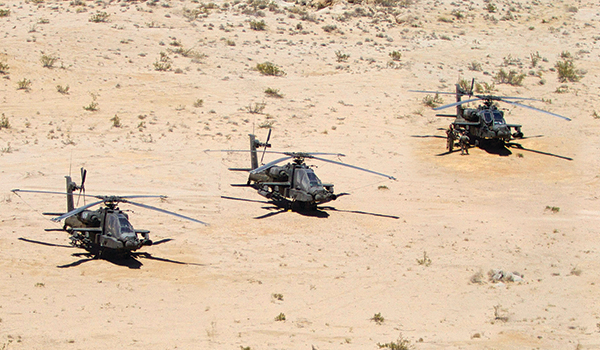
Reserve Components / By COL J. Ray Davis: Greetings again from your Army National Guard (ARNG). It’s been a few months since I’ve had the chance to share some observations, but even though the following is somewhat dated, it’s still relevant.

Arizona Army National Guard AH-64 Apache helicopters at a task force field site at the National Training Center, Fort Irwin, CA, June, 2016./ ARIZONA ARMY NATIONAL GUARD PHOTO
In late June, I had the opportunity to visit the National Training Center at Fort Irwin, CA and observe the ARNG Aviation Task Force that was supporting Minnesota’s 1-34th Armored Brigade Combat Team (ABCT). The Task Force was comprised of Guardsmen from seven states, with the majority coming from Arizona (which provided the TF headquarters and an attack-reconnaissance company) and Georgia (which provided cargo, utility, and air ambulance capabilities).
During my assembly area visit, I was struck by the professionalism, tactical competence, and enthusiasm of all the soldiers I encountered, despite temperatures reaching 118 degrees and a stressful tactical environment. As we (the Guard) increase our participation at the combat training centers (CTC), aviation brigade commanders must exploit this marquis training opportunity as a tool to enhance its Sustainable Readiness Process training, leading to company proficiency in combined arms maneuver on the unit’s available or mobilization date. Here’s a takeaway from my visit that I’d like to open up to the forum: I think we (Guard, Reserve, and Regular Army) might want to consider a common core standard operating procedure (SOP). I saw three units operating from three different SOPs, leading to some needless interoperability “challenges.” While there was little impact on mission accomplishment, confusion and risk were both unnecessarily elevated. I acknowledge the need for mission and locationspecific annexes to our SOPs, but there’s no reason why flashing position lights means one thing at Fort Bragg and another in Indiantown Gap. Is it time for us to come together at Fort Rucker to develop an Army Aviation core TACSOP?
Another area to consider for standardization is the Risk Assessment Worksheet (RAW). I’m well aware of the philosophy and directives of Appendix B of AR 95-1, and as above, I also acknowledge the need for mission- and location-specific blocks within the RAW. But shouldn’t the risk associated with a 300-hour pilot in command be the same at Fort Carson and Camp Atterbury? More food for thought for those senior leaders who will be gathering at Rucker in two months.
My visit to NTC was both refreshing and encouraging. ARNG Aviation remains a critical, competent, and engaged member of the Army Aviation team, and will continue to contribute at the training centers, in the communities, and in the combat zone.
Stay Safe…Fly Guard.
COL J. Ray Davis is the chief of the Army National Guard Aviation and Safety Division located in Arlington, VA.








